From Discovery to Impact: Mapping the Science-to-Innovation Supply Chain
Determinants of knowledge transfer (AI)
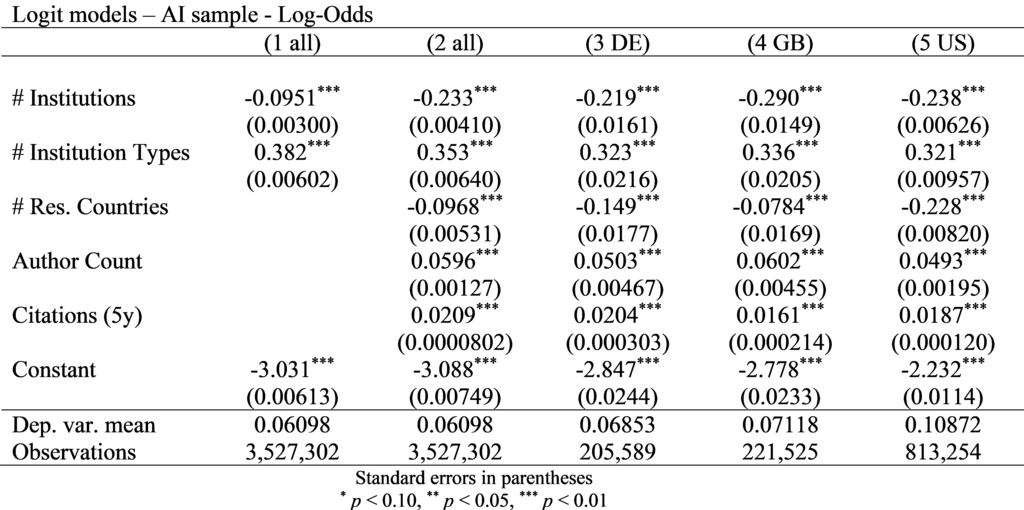 Reading example: The number of institutions and participating countries is negatively correlated with the log odds of a patent citation, whereas the diversity of institution types, the number of authors, and citations within five years are positively correlated. The direction of these effects is consistent across Germany, France, and the US, but the magnitude varies between countries.
Reading example: The number of institutions and participating countries is negatively correlated with the log odds of a patent citation, whereas the diversity of institution types, the number of authors, and citations within five years are positively correlated. The direction of these effects is consistent across Germany, France, and the US, but the magnitude varies between countries.
Descriptive analysis of the observed mean transfer rate (MTR) as a function of different factors influencing knowledge transfer (AI)
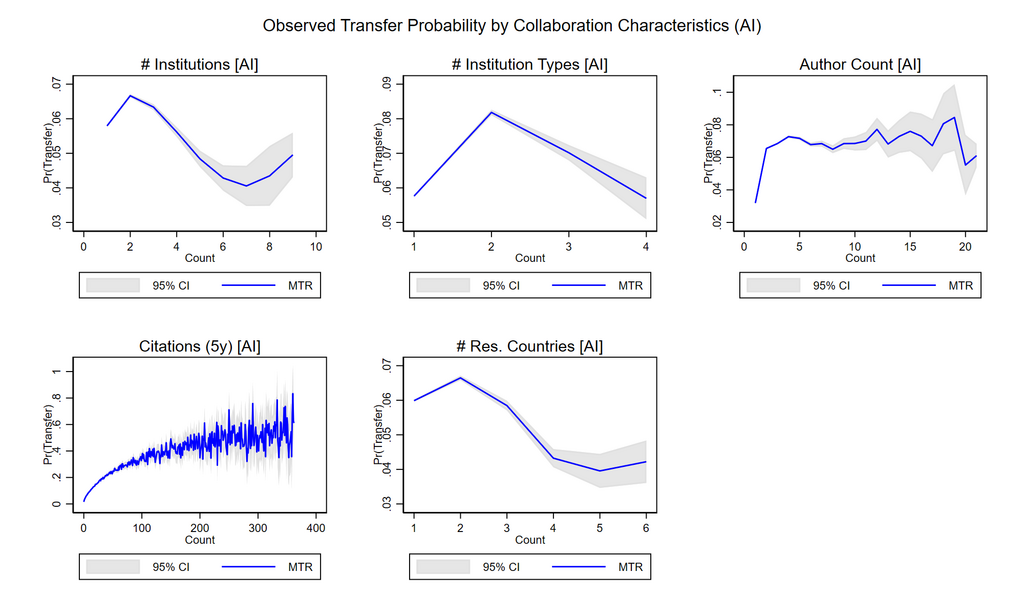 Reading example: The mean transfer rate reaches its highest value with two participating institutions. It then declines to around seven institutions before increasing again. Institutional diversity peaks with two institution types and then decreases continuously.
Reading example: The mean transfer rate reaches its highest value with two participating institutions. It then declines to around seven institutions before increasing again. Institutional diversity peaks with two institution types and then decreases continuously.
Descriptive analysis of the smoothed estimated transfer probability as a function of various factors influencing knowledge transfer (AI)
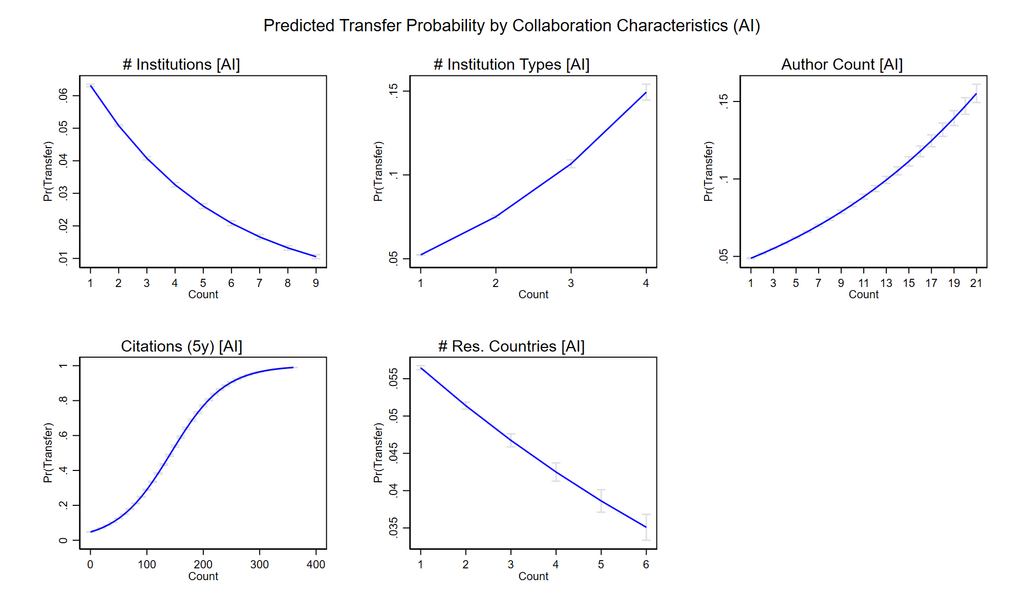 Reading example: The estimated transfer probability decreases with an increasing number of participating institutions and countries, while it increases with greater institutional diversity and a larger number of authors. The number of citations within 5 years reaches its maximum at around 300 citations.
Reading example: The estimated transfer probability decreases with an increasing number of participating institutions and countries, while it increases with greater institutional diversity and a larger number of authors. The number of citations within 5 years reaches its maximum at around 300 citations.
Changes in the effects of different knowledge transfer determinants (AI)
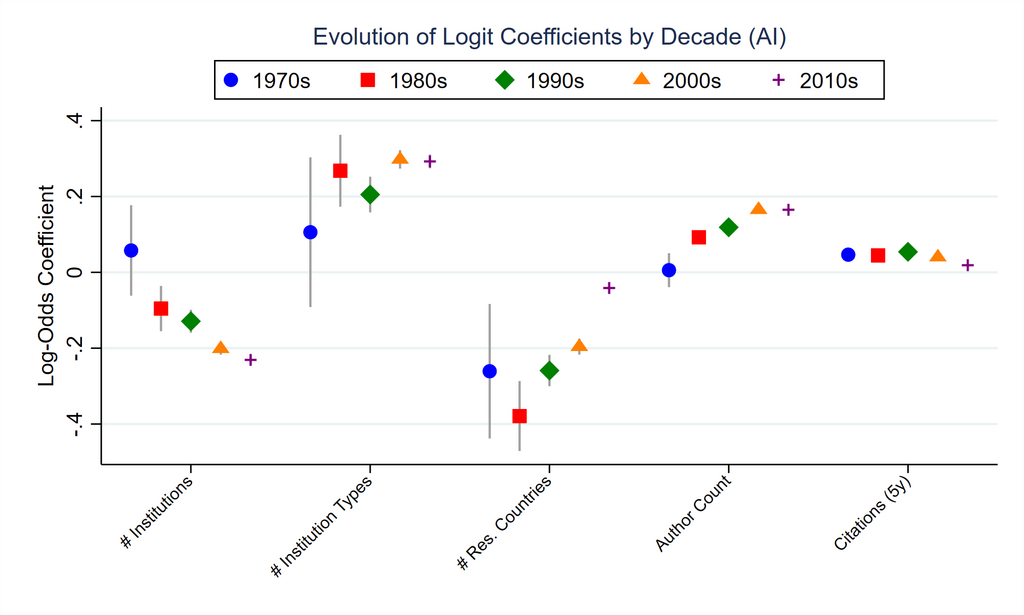 Reading example: a higher number of institutions has an increasingly negative effect on the log odds, whereas the diversity of institution types has a consistently positive effect on the log odds of a patent citation.
Reading example: a higher number of institutions has an increasingly negative effect on the log odds, whereas the diversity of institution types has a consistently positive effect on the log odds of a patent citation.
Note: The values shown are logistic regression coefficients that represent the influence of each factor on the log odds.
Determinants of Knowledge Transfer in AI – Logit Regression by Decade
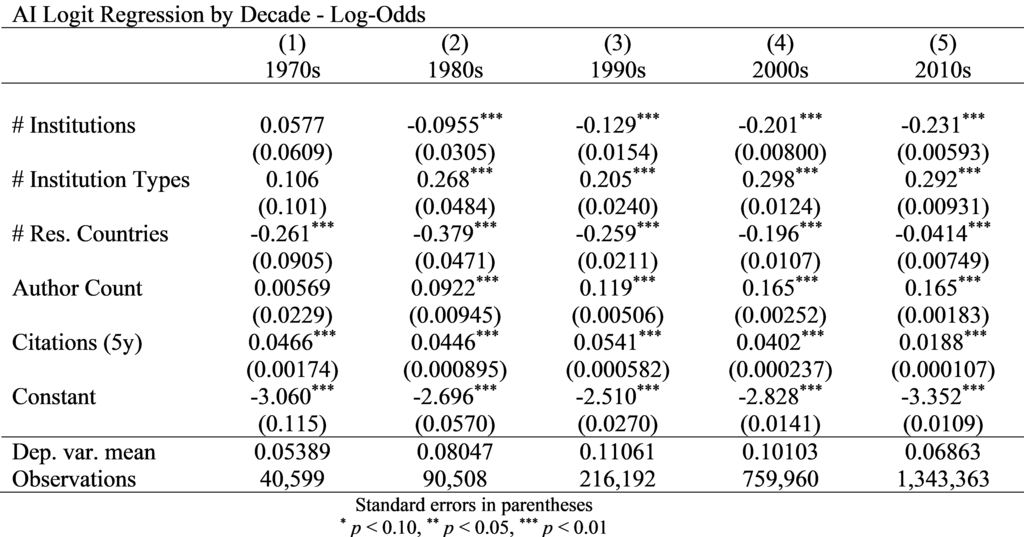 The effect of institutional diversity on the log odds of patent citation is consistently positive across decades. In contrast, the number of institutions and countries involved tends to reduce citation likelihood.
The effect of institutional diversity on the log odds of patent citation is consistently positive across decades. In contrast, the number of institutions and countries involved tends to reduce citation likelihood.
Growth of scientific publications in AI (logarithmic scale)
 The figure shows the annual number of scientific publications in the field of AI. Overall, a continuous increase can be observed, with publication volumes rising particularly since the 1990s.
The figure shows the annual number of scientific publications in the field of AI. Overall, a continuous increase can be observed, with publication volumes rising particularly since the 1990s.
Knowledge emission of AI publications by institution types over time (1970-2024)
 Reading example: Educational institutions account for the highest proportion of scientific publications, reaching 80% in 2010. Since the 1990s, their share of publications cited in patents has also increased substantially. Companies contribute a relatively small share of publications, yet the proportion of these publications cited in patents is comparatively high.
Reading example: Educational institutions account for the highest proportion of scientific publications, reaching 80% in 2010. Since the 1990s, their share of publications cited in patents has also increased substantially. Companies contribute a relatively small share of publications, yet the proportion of these publications cited in patents is comparatively high.
Determinants of knowledge transfer (Quantum)
 Reading example: The number of institutions and participating countries is negatively correlated with the log odds of a patent citation, whereas the diversity of institution types, the number of authors, and citations within five years are positively correlated. The direction of these effects is consistent across Germany, France, and the US, but the magnitude varies between countries.
Reading example: The number of institutions and participating countries is negatively correlated with the log odds of a patent citation, whereas the diversity of institution types, the number of authors, and citations within five years are positively correlated. The direction of these effects is consistent across Germany, France, and the US, but the magnitude varies between countries.
Descriptive analysis of the observed mean transfer rate (MTR) as a function of different factors influencing knowledge transfer (Quantum)
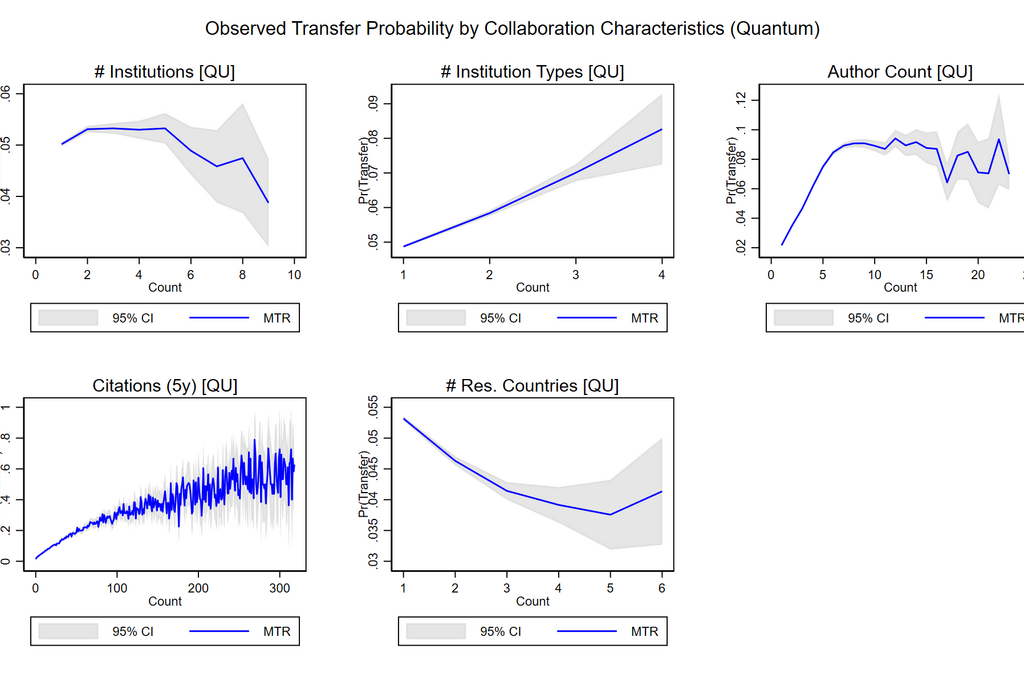 The observed transfer probability is highest for two to three participating institutions and decreases thereafter. Greater institutional diversity is associated with a steady increase in transfer probability. For author count, the effect rises quickly up to around ten authors and then plateaus. Citation impact increases up to about 300 citations before stabilizing. Transfer probability decreases with more countries involved, though uncertainty increases at higher values.
The observed transfer probability is highest for two to three participating institutions and decreases thereafter. Greater institutional diversity is associated with a steady increase in transfer probability. For author count, the effect rises quickly up to around ten authors and then plateaus. Citation impact increases up to about 300 citations before stabilizing. Transfer probability decreases with more countries involved, though uncertainty increases at higher values.
Descriptive analysis of the estimated transfer probability as a function of various factors influencing knowledge transfer (Quantum)
 The predicted transfer probability declines as the number of participating institutions and countries increases, while it rises with greater institutional diversity and a higher number of authors. For citation impact, the probability increases sharply and plateaus at around 300 citations.
The predicted transfer probability declines as the number of participating institutions and countries increases, while it rises with greater institutional diversity and a higher number of authors. For citation impact, the probability increases sharply and plateaus at around 300 citations.
Changes in the effects of different knowledge transfer determinants (Quantum)
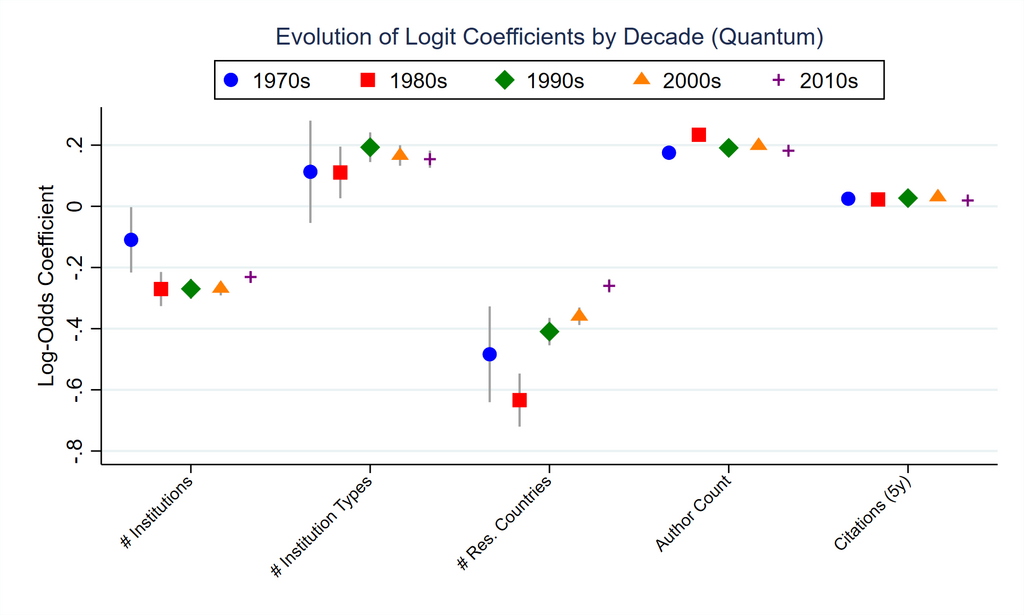 The number of institutions shows a consistently negative association with the log odds of a patent citation, while the diversity of institution types is positively associated across all decades. In contrast, the effect of international collaboration (# Res. Countries) is strongly negative in earlier decades and becomes less pronounced over time.
The number of institutions shows a consistently negative association with the log odds of a patent citation, while the diversity of institution types is positively associated across all decades. In contrast, the effect of international collaboration (# Res. Countries) is strongly negative in earlier decades and becomes less pronounced over time.
Note: The values shown are logistic regression coefficients that represent the influence of each factor on the log odds.
Determinants of Knowledge Transfer in Quantum Technologies – Logit Regression by Decade
 Reading example:The diversity of institution types shows a consistently positive correlation with the log-odds of a patent citation, although the strength of this correlation varies over the years. For example, the log odds were 0.113 in the 1970s and 0.154 in the 2010s.
Reading example:The diversity of institution types shows a consistently positive correlation with the log-odds of a patent citation, although the strength of this correlation varies over the years. For example, the log odds were 0.113 in the 1970s and 0.154 in the 2010s.
Growth of scientific publications in Quantum (logarithmic scale)
 The figure shows the annual number of scientific publications in the quantum field. Apart from a decline in the 1940s, a continuous increase can be observed from 1950 onwards.
The figure shows the annual number of scientific publications in the quantum field. Apart from a decline in the 1940s, a continuous increase can be observed from 1950 onwards.
Knowledge emission of Quantum publications by institution types over time (1970-2024)
 Reading example: The share of scientific publications from educational institutions has increased continuously over the years. Since the 1990s, their share of cited scientific publications in patents has also increased substantially, while the corresponding share from companies has declined.
Reading example: The share of scientific publications from educational institutions has increased continuously over the years. Since the 1990s, their share of cited scientific publications in patents has also increased substantially, while the corresponding share from companies has declined.
I agree that a connection to the Vimeo server will be established when the video is played and that personal data (e.g. your IP address) will be transmitted.
I agree that a connection to the YouTube server will be established when the video is played and that personal data (e.g. your IP address) will be transmitted.
Show video







